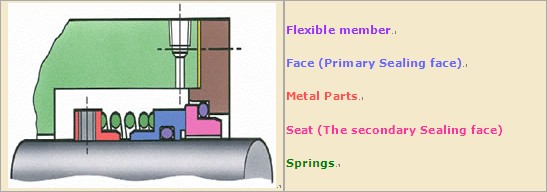All mechanical seals must contain the four elements: 1) Primary sealing surfaces, 2) Secondary sealing surfaces, 3) a means of actuation and 4) a means of drive.
1) The primary sealing surfaces are the heart of the device. A common combination consists of a hard material, such as silicon carbide or tungsten carbide, embedded in the pump casing and a softer material, such as carbon in the rotating seal assembly. Many other materials can be used depending on the liquid's chemical properties, pressure, and temperature. These two rings are in intimate contact, one ring rotates with the shaft, the other ring is stationary. These two rings are machined using a machining process called lapping in order to obtain the necessary degree of flatness.
2) The secondary sealing surfaces (there may be a number of them) are those other points in the seal that require a fluid barrier but are not rotating relative to one another.
3) In order to keep the two primary sealing surfaces in intimate contact, a means of actuation must be provided. This is commonly provided by a spring. In conjunction with the spring, it may also be provided by the pressure of the sealed fluid.
4) The primary sealing surfaces must be the only parts of the seal that are permitted to rotate relative to one another, they must not rotate relative to the parts of the seal that hold them in place. To maintain this non-rotation a method of drive must be provided


